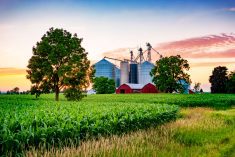Farming takes an uncommon amount of willpower and commitment to make things work despite the many uncertainties that farmers everywhere know all too well. It’s a skill that’s groomed in each new generation as it comes along, and it’s often tied to the peculiarities of the same tract of land that’s been in the family, and WILL be in the family, for generations. Cropping practices may change, the production of livestock may shift, the family might add storage or other enterprises, or hire more employees, but for the most part, the “home farm” remains a constant.
Read Also

The big squeeze: How to be fair to siblings during farm succession
Managing sibling business relationships on family farms.
So why would a young family leave home in Wellington County to farm in Ontario’s Near North? It’s a question that David Schill can answer with just one word: Opportunity.
Together his father Larry and the brothers Shawn, Mike and David purchased their first farm here in the summer of 2002, with David taking up permanent residence just north of Earlton — boots on the ground, so to speak — in 2004. Today, David and his wife Stephanie are the sole operators of nearly 20,000 acres, with about 3,500 acres belonging to Larry and Shawn.
“Getting on sizeable tracts of land back in those days was very easy,” says Schill. He recalls the days after the outbreak of bovine spongiform encephalopathy (BSE) in the early 2000s, when there was plenty of available land at affordable prices. “It was a very feasible opportunity for young farmers to get started.”
In the early 2000s, the Temiskaming region — roughly bounded by New Liskeard in the south and Earlton to the north — was expanding and it had begun building the kind of infrastructure that producers in more established farm regions take for granted.

Today, the municipality of Temiskaming Shores boasts a well-established core of seed dealers, farmer co-ops and storage facilities to complement farm financing and other business-related ventures, and it is home to a vibrant farming community that is widely recognized for its importance to the region, something that Schill has noticed.
“It’s comforting to know that for the most part, the community is in support of agriculture,” he says. “As the northeast continues to be redeveloped and grow, there’s a plethora of opportunities for the entrepreneurial-minded. Ag builders, land-clearing and drainage work, fruit and berry farms, fruit stands and market gardens, custom farm operators and machinery and tire shops have all popped up and seem to be flourishing.”
Change in mindset
Although the Temiskaming to Earlton region is growing and solidifying its farm industry, the harsh reality facing growers is the shorter growing season, which usually means abandoning the corn that is the staple of farming farther south. According to 2019 Ontario statistics, Timiskaming (its official designation) harvested only 200 acres of grain corn and 1,570 acres of silage.
Schill says it means growers moving into the district need to accept that corn won’t likely be their main crop. And they also need to learn to take the time that the region insists on to learn what else they can and cannot expect.
“The 2020 growing season turned out to be a fantastic soybean year for the northeast, whereas canola, cereals and wheat were not record-breaking, but a very healthy average crop,” says Schill. “Most fields of soybeans averaged in the 42- to 52-bushel range, which is exceptional for this area. It’s very easy to fall into the trap that this could be the ‘normal’, and I’ve learned from past experiences that it’s important to plan your rotation, not on the home runs, but rather base hits and averages. I’ve cut a lot of 25-bushel bean crops up here, and that’s just a reality.”

There are also those who have been trying alternatives in the region — crops like faba beans, dry (edible) beans, even potatoes. Some have noted that malt barley from the Near North is that much closer to breweries in Montreal compared to Western Canada.
The key, Schill says, is to keep reasonable expectations for crop performance as well as transportation costs in mind.
As for whether the region can sustain more migration, that’s a matter of perspective. On the positive side, a grower from southwestern Ontario might welcome land prices that are comparatively lower than $20,000 to $25,000 per acre; Schill agrees that Temiskaming looks attractive and that there are still plenty of growers coming north. Dairy farms are also doing well. But from a cash-crop perspective, land values are becoming stretched beyond an economical threshold, especially factoring in the substantial logistics aspect.
“Economy-of-scale models are quickly becoming harder to justify, no matter what size the farm is or where it’s located,” says Schill. “Machinery costs, parts, fuel, crop inputs and labour have increased immensely in the past 10 years while — of course — commodity prices haven’t kept pace. The increase in land values coinciding with these variable costs makes the positive economic outcome of new startups very challenging.”
Where he sees success for young people in agriculture in the Near North follows more of a pattern of starting small — a farm with a good house — and building from there. Once that’s secure, they can work off-farm to supplement their income. The better arrangement, he believes, is to work with or for established farmers and work their own acres on evenings and weekends. It isn’t easy. It takes hard work and dedication, but it can be a short-term path with a long-term gain.

Dairy is also a thriving sector in Temiskaming, despite a slight recent drop in farm cash receipts across the district. One of the benefits with dairy comes when the logistical cost component is removed on shipping milk. It’s worth noting that much of that loss in dairy value in the region was more than compensated for by a jump in value in soybeans — from $2.27 million in 2011 to $10.66 million five years later.
The important thing in farming is knowing a farm’s cost of production. That’s important anywhere, but Schill makes the case for paying even closer attention when farming in the north. He’s tried to incorporate cover crops, biologicals and different tillage practices, along with variable-rate technology, all in an effort to increase profitability, yet he’s found that positive returns have been rare on his farm.
“Know your costs and build in a reasonable margin,” he says. “Only ‘expect’ and budget for average… As similar as farming can be from one area to the next, there are always vast differences that can’t really be taught, only learned. It’s always a battle up here to balance input costs against what the weather will do.”
Other considerations
Conditions here can be difficult, and some of the lessons he’s learned through the years have been harsh, but the Schills have adapted and succeeded, and in their 16 years in the district, they’ve watched as the agricultural community has grown and expanded to meet increased demand from a solid farm base.
Even so, Schill repeats that life in the north isn’t for everyone. There are challenges that can be hard to overcome: the day-length in summer is longer than he had in southern Ontario but frost often comes early in the fall and the sun sets earlier during winter. Those can be difficult realities to deal with and he’s seen many younger farmers surrender to the short season and the differences in the weather conditions.

Schill says he had an advantage, being raised in the relatively short-season North Wellington and Dufferin areas of southern Ontario, where he learned the value of quality cereal crops and long rotations in a cooler climate. “This has served me extremely well in my transition to the north,” says Schill.
“It’s also essential that one’s family and married life are solid when coming north; farmers will need that support system in place when the frosts hit and the snow flies at harvest.”















